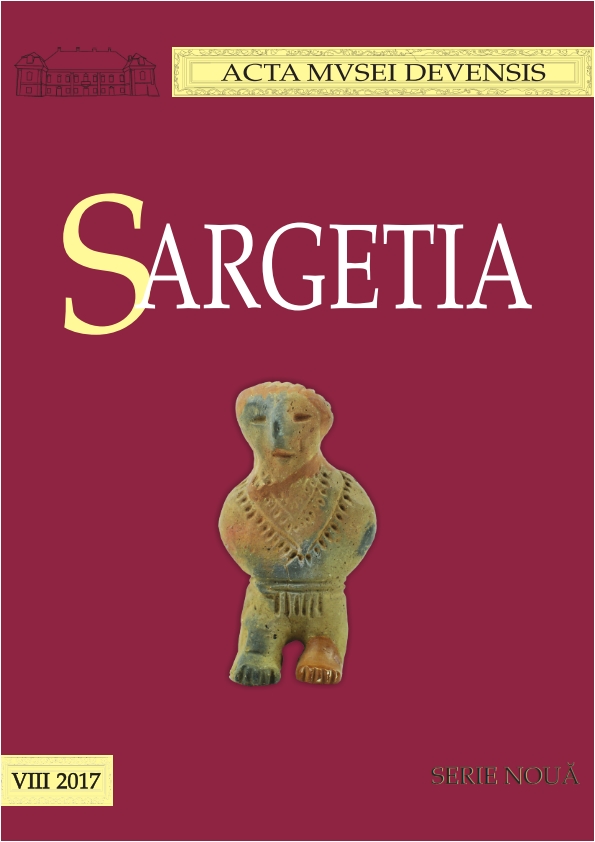Aşezări Coţofeni şi Wietenberg din judeţul Hunedoara
Coţofeni and Wietenberg Settlements from Hunedoara County
Author(s): Octavian-Cristian Rogozea, Florentina Mărcuţi, Răzvan Guguţ, Simion CâmpeanSubject(s): History, Archaeology
Published by: Editura Altip
Keywords: field survey; settlement; cave; Eneolithic; Bronze Age
Summary/Abstract: The understanding of how habitats are chosen by some human communities has represented the main preoccupation of most archaeology studies of landscape. Unfortunately, for many archeological eras and archaeological cultures there are no exact data on the location of the settlements even if they are well known in the specialty bibliography.The present study aims to add another four sites to the repertoire of settlements attributed to the Coţofeni culture, sites known with exact geographic coordinates: Bulzeştii de Sus – Peştera Ionileşti/Peştera de sub Bulz (Fig. 1, Pl. I/1), Călan – Măgura Călanului (Fig. 2-3, Pl. I/3) and Chimindia – 1 (Fig. 4, Pl. I/4). In the case of one settlement from Călan – Măgura Călanului, a few fragments that can be attributed to the Bronze Age, Wietenberg culture (Pl. II/8-9, III/6) along with the numerous Coţofeni materials have been identified (Pl. II/4-7, III/1-5).Peştera Ionileşti also known as Peştera de sub Bulz is accessible through three entrances located in the Piatra Bulzului Massif, Bulzeştii de Sus commune, Hunedoara County. The pottery found on the cave floor in 2011 (Pl. I/2) belongs to the third phase of the Coţofeni culture (Pl. II/1-3).The archaeological potential of Măgura Călanului is known from an older specialty bibliography due to the random discoveries and exploitation of stone dale. Further field research dated from 2014 led to the identification of an area of materials attributed to the Coţofeni (Pl. II/4-7, III/1-5) and Wietenberg culture (Pl. II/8-9, III/6). At this point, a circular structure was identified on the aerial photographs (Pl. I/3). Materials attributed to the Coţofeni culture are also mentioned at Chimindia, which have been mentioned by Márton Roska but without specifying an exact area, since 1942. A site with materials attributed to the Coţofeni culture, phase III (Pl. III/7-8, IV/1-6, V/1-8, VI/1-8, VII/1-5, VIII/1-5, IX/1-6, X/1-4, XI/1-5, XII/1-6), was identified during the field research in 2017 (Pl. I/4) and it is likely to be the same site as the one known from Márton Roska’s study. Also, pottery specific to the Coţofeni culture was discovered on the territory of Mada locality (Pl. XIII/1-6), more precisely, at the entrance to the Mada Gorge in 2017 (Pl. I/5). From chronological point of view the pottery and decorations allow us to classify the settlements from Chimindia – 1, Călan – Măgura Călanului and Bulzeştii de Sus – Peştera Ionileşti/Peştera de Sub Bulz in the IIIrd phase of the Coţofeni culture with good analogies in other sites in Hunedoara County: Bretea Mureşană, Cărmăzăneşti – Peştera D1 and D3, Deva – Dealul Cetăţii, Găvojdia – Peştera La Cruce, Ghelari – Pensiunea Panorama, Haţeg (Silivaşu de Jos) – La Cruce, Haţeg – Între Ogăşi/Între Ogăşii/Între Ogrăzi, Hăşdat – În Cânepi and Prihodişte – Peştera Prihodişte. In Alba County our materials have good analogies in the sites from: Aiud, Balomiru de Câmp – După Sat, Balomiru de Câmp – Gura Văii Cioarei, Balomiru de Câmp – Săteşti, Blandiana – Pleşa, Bucuru – Vârfu Bucuru, Căpâlna – Gorgan, Căpâlna – Vârful Ştetii, Căpâlna – Dealul Cetăţii, Câlnic – Dealul Mare, Cetea, Cugir – Cioaca Bălinteasa, Cugir – Dealul Brădetului, Cugir – Gura Luncilor-ob. 2, Cugir – Piatra Pleşii, Dumbrava – Pojeră, Galaţi – Bulbuce, Geoagiu de Sus – Cuciu, Geoagiu de Sus – Sub Măgură, Gura Arieşului – Între Dealuri, Lunca Meteşului – Pleşa Înaltă, etc. In Caraş-Severin County, pottery of this type is known from the discoveries made at: Bănia – Cracu Otara, Bocşa – Gruniul Cetăţii, Bogâltin, Caraşova – Peştera Cerbului, Dubova – Cuina Turcului, Herculane – Peştera Hoţilor (levels h-f), Mehadica – Cioaca Mică, Moldova Veche – Humca (inferior level), Peştera Oilor, Cuptoare – Piatra Ilişovii and Vârful Gogâltan. Also in Arad and Timiş Counties settlements with such materials are known. In Arad County, Coţofeni III materials are known at: Săvârşin – Dealul Cetăţii/Dealul Cetăţeaua. Analogies for materials from the three new sites attributed to the Coţofeni III phase in Hunedoara County are found in Timiş County at: Româneşti – Peştera Româneşti/Peştera cu Apă.The small amount of Wietenberg culture materials discovered on Măgura Călanului complete our knowledge in distribution of such sites in Hunedoara County and come in addition to the approx. 67 sites discovered so far. The lack of a clear discovery context and several characteristic elements does not allow us to specify a certain phase. The closest points with such materials are reported at: Federi, Gânţaga, Hăşdat, Jeledinţi, Peştişu Mare, Turdaş, etc.
Journal: Sargetia. Acta Musei Devensis
- Issue Year: 2017
- Issue No: 8
- Page Range: 149-175
- Page Count: 27
- Language: Romanian

